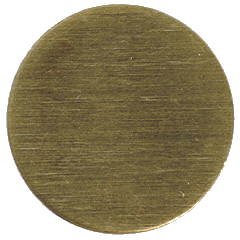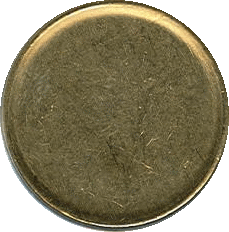
SACAGAWEA DOLLAR BLANK
PHOTO COURTESY OF
KEVIN THOMPSON

SACAGAWEA DOLLAR PLANCHET
PHOTO COURTESY OF
KEVIN THOMPSON
Sacagawea
Dollar Blanks, Planchets, |
|
|
|
| Blanks have a flat, sharp edge. They are just as they were punched from the strip. Sacagawea Dollar blanks are presently extremely rare. Blanks are generally refered to as "type 1". | Planchets, generally refered to as "type 2", have been run through an upset mill. Note the raised, rounded rim. This is done to help form the rim on the struck coin and extend the life of the coin. |
GOLDEN DOLLAR PLANCHET STRIP
|
Here is a relatively large (8¼" x 4") piece of planchet strip for the golden dollar. Since the blanks for the Sacagawea Dollar and the Presidential Dollars are the same, this strip could have been used for either. This example has 17 complete holes and 15 partial holes. Viewed from the edge, it exhibits the pure copper core and outer layers of copper/nickel/manganese/zinc. |
|
For the first time ever, several of the grading services began to actually assign a date to a blank planchet. Any Sacagawea Dollar that they received for authentication in the year 2000, the first year of issue, was given the year designation on the insert. Here are two such examples. Initially, the grading services didn't assign a date to a blank planchet. Click Here to read how a 12-year old numismatist changed that policy at PCGS and NGC. |
|
|
2006-P Sacagawea Dollar Planchet In early to mid-2006, an
unopened, original mint-wrapped roll of 2006 |
WAFFLED SACAGAWEA DOLLARS
|
PHOTOS COURTESY
OF FRED
WEINBERG |
|
| Before selling defective coins unfit for circulation as scrap metal, the U. S. Mint runs the defective pieces through a cancelling machine. The cancelling machine gives the coins a distinctive "waffle" pattern, hence the nickname "waffled coins". This cancellation procedure renders the pieces unusable in commerce. However, since they were cancelled inside the Mint's facilities, they have become highly collectible. | ||